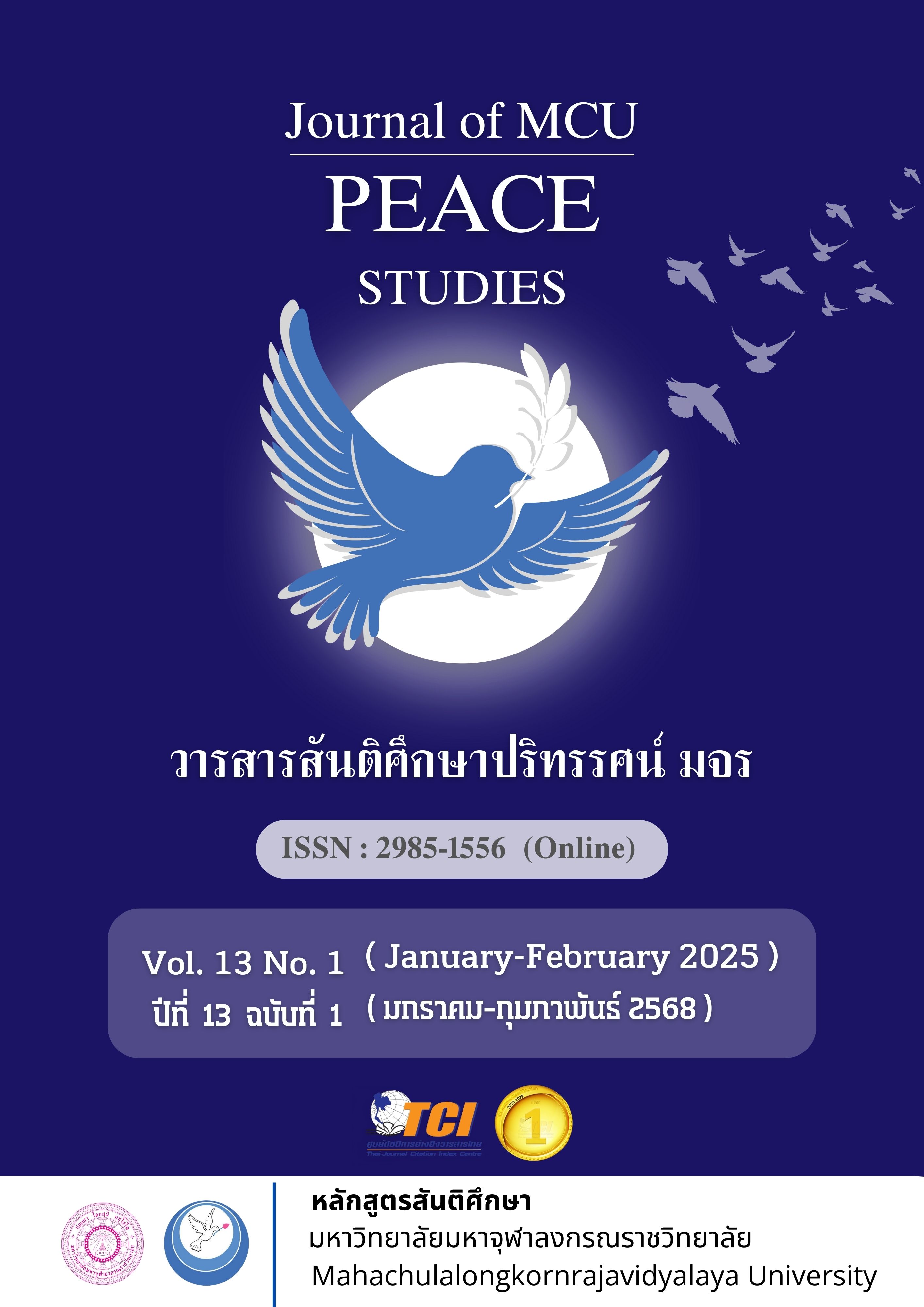พุทธบูรณาการกับการฝึกภาคปฏิบัติทางสังคมสงเคราะห์
Main Article Content
บทคัดย่อ
บทความวิจัยนี้ มีวัตถุประสงค์เพื่อ 1) ศึกษาหลักพุทธธรรมที่นำไปใช้ในการฝึกภาคปฏิบัติสังคมสงเคราะห์ 2) ศึกษาวิธีบูรณาการหลักพุทธธรรมกับงานสังคมสงเคราะห์ 3) เพื่อเสนอแนวทางการบูรณาการการฝึกภาคปฏิบัติของหลักสูตรสังคมสงเคราะห์ศาสตรบัณฑิต มหาวิทยาลัยมหามกุฎราชวิทยาลัย เป็นการวิจัยแบบผสมผสาน ประชากรที่ใช้ศึกษา คือ นักศึกษาสาขาวิชาสังคมสงเคราะห์ศาสตร์ มหาวิทยาลัยมหามกุฏราชวิทยาลัยส่วนกลางและวิทยาเขตอีสานที่ลงทะเบียนเรียนในรายวิชาการฝึกภาคปฏิบัติ 1 การฝึกภาคปฏิบัติ 2 และการฝึกภาคปฏิบัติ 3 โดยเก็บข้อมูลทุกรูป/คน อาจารย์ประจำหลักสูตรสังคมสงเคราะห์ศาสตร์และอาจารย์ที่ปรึกษาภาคสนาม รวมทั้งสิ้น 77 รูป/คน
ผลการวิจัยพบว่า 1. มีการใช้หลักพุทธธรรม (สัปปุริสธรรม 7) ทุกด้านในระดับมากที่สุดในการฝึกภาคปฏิบัติของนักศึกษา โดยด้านที่มากที่สุดได้แก่ ด้านกาลัญญุตา (ผู้รู้จักกาล) ด้านมัตตัญญุตา (ผู้รู้จักประมาณ) ด้านธัมมัญญุตา (ผู้รู้จักเหตุ) ด้านอัตตัญญุตา (ผู้รู้จักตน) ด้านปุคลัญญุตา (ผู้รู้จักบุคคล) ด้านอัตถัญญุตา (ผู้รู้จักผล/รู้จุดมุ่งหมาย) และ ด้านปริสัญญุตา (ผู้รู้จักชุมชน) ตามลำดับ 2. การบูรณาการ หลักพุทธธรรมกับสังคมสงเคราะห์ นักศึกษามีการบูรณาการหลักพุทธธรรมกับสังคมสงเคราะห์ในระดับมากที่สุด ในเรื่องการบูรณาการด้านความรู้เกี่ยวกับการปฏิบัติงานพื้นฐาน ด้านเทคนิค ด้านทัศนคติ ด้านทักษะ และด้านหลักการให้บริการของนักสังคมสงเคราะห์ 3. ด้านความคิดเห็นต่อแนวทางการบูรณาการหลักพุทธธรรมสำหรับการฝึกภาคปฏิบัติทางสังคมสงเคราะห์ นักศึกษามีความคิดเห็นต่อแนวทางการบูรณาการหลักพุทธธรรมสำหรับการฝึกภาคปฏิบัติทางสังคมสงเคราะห์ด้านอาจารย์ มากที่สุด รองลงมาด้านนักศึกษา ด้านหลักสูตร และด้านหน่วยงานฝึกภาคปฏิบัติ ตามลำดับ
Article Details

This work is licensed under a Creative Commons Attribution-NonCommercial-NoDerivatives 4.0 International License.
ทัศนะและความคิดเห็นที่ปรากฏในบทความในวารสาร ถือเป็นความรับผิดชอบของผู้เขียนบทความนั้น และไม่ถือเป็นทัศนะและความรับผิดชอบของกองบรรณาธิการ ยินยอมว่าบทความเป็นลิขสิทธิ์ของวารสาร
References
Announcement of the Social Work Professional Council regarding the Standards of service for Social Work Professionals B.E. 2564 (2021, June 30). Royal Gazette. Volume 138, Special Section 144.
Association of Experiential Education (AEE). 2003. Definition of Experiential Education. Retrieved February 5, 2016, from https://www.aee.orgndef.html
Bachelor of Social Work Program in Social Work. (2020). Faculty of Social Sciences. Nakhon Pathom: Mahamakut Buddihist University.
Boonyarattanasoontorn, J., Kumhom, R., Kammanat, Y., & Kamdang, Th. (2021). Creating Value and Core Competencies of Professional Social Workers. Journal of Social Work, 29(1), 294-328.
Chaiyaphan, T. (2017). An Application of Buddhadhamma for Promoting Administrative Effectiveness in Local Administrative Organizations in Ubon Ratchatani Province. (Doctoral Dissertation). Mahachulalongkornrajavidyalaya University. Ayutthaya.
Chankhiaw, S. (2016). Learning Management on Buddhism through Integrated Buddhist Methods. CMRU Ganesha Journal, 12(1), 15-27.
Course Professor Central 1. (2023). Professor. Interview. June, 10.
Detophat, Y. (2022). Application of the Buddhist Principle of Suppurisadhamma by School Administrators Affecting the Happiness in the Workplace at Schools under Rayong Primary Educational Service Area Office 2. (Master’s Thesis). Rambhai Barni Rajabhat University. Chanthaburi.
Dockthaisong, B., Raksamueng, S., & Maharattanasakul, p. (2017). The Integrative Buddhism Principles to Read the Profound Public Administration to Build the Mahachulalongkornrajavidyalaya Intelectual Capital through Higher Learning and Ready Toward AEC. Journal of MCU Social Science Review, 6(2), 69-84.
Jedsadawiroj, S. (2003). The Integration of Teaching and Learning Management. Bangkok: Book Point Company Limited.
Khammani, T. (2005). Teaching Science: Knowledge for Organizing Effective Learning Process. (4th ed.). Bangkok: Dansuttha Printing Company.
Kumhom, R. (2013). The Principle and Processes of Micro Social Work Practice. (2nd ed.). Bangkok: Thammasat University Press.
Lappin, E. (2000). Outdoor Education for Behavior Disturbed Student. Washington, D. C.: ERIC Digest.
Ministry of Education. (2010). National Education Ace off 1999, Amended (No 2) B.E. 2022 and (No 3) B.E. 2010. Bangkok: Printing House Transport Organization and Parcel.
Parimethachai, P. (2022). BuddhaDhamma Integration for Human Resource Development of the Office of Contemporary Art and Culture. (Doctoral Dissertation). Mahachulalongkornrajavidyalaya University. Ayutthaya.
Phra Dhammakosajarn (Prayoon ThammaJitto). (2009). The Method of Integrating Buddhism with Modern Sciences. Ayuthaya: Mahachulalongkornrajavidyalaya University Press.
Phra Promwihan Athidhammo (Daendongying). (2021). The Desirable Characteristics of the Local Politicians in Khon Kaen Municipality. (Master’s Thesis). Mahachulalongkornrajavidyalaya University University. Ayutthaya.
Podapol, P., & Podapol,p. (2020). Application of Administrative Principle on Suppurisa-Dhamma to Administration of Sub-District Administrative Organizations in Phon Thong District, Roi Et Province. Journal of Srilanchang Review, 6(2), 83-93.
Practical Training Students 1 Isan Campus. Student. Interview. May, 23.
Practical Training Students 2 Central Campus. Student. Interview. June, 20.
Practical Training Students 2 Isan Campus. Student. Interview. May, 23.
Practical Training Students 3 Isan Campus. Student. Interview. May, 23.
Priest, S. (1990). The Semantics of Adventure Education. In Miles, J. C. & Priest, S. (Eds.). Adventure Education (pp. 113-117). State College, PA: Venture Publishing.
Suknaisith, A. (2021). Learning Management Outside the Classroom to Develop Project Evaluation Skills for of Bachelor of Arts Program Students Research Field in Sociology for the Development. Research and Development Institute Journal of Chaiyaphum Rajabhat University, 3(2), 84-95.

